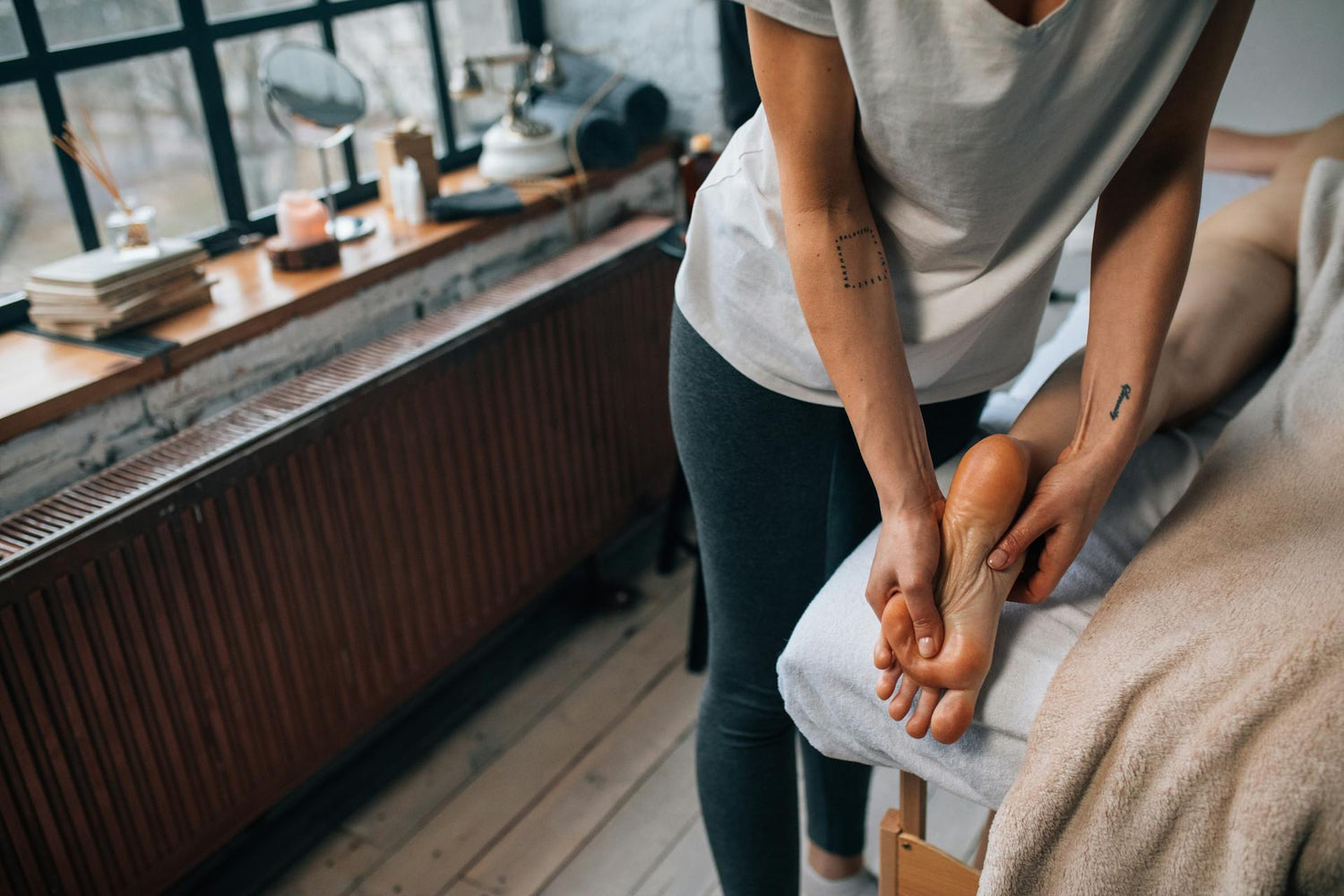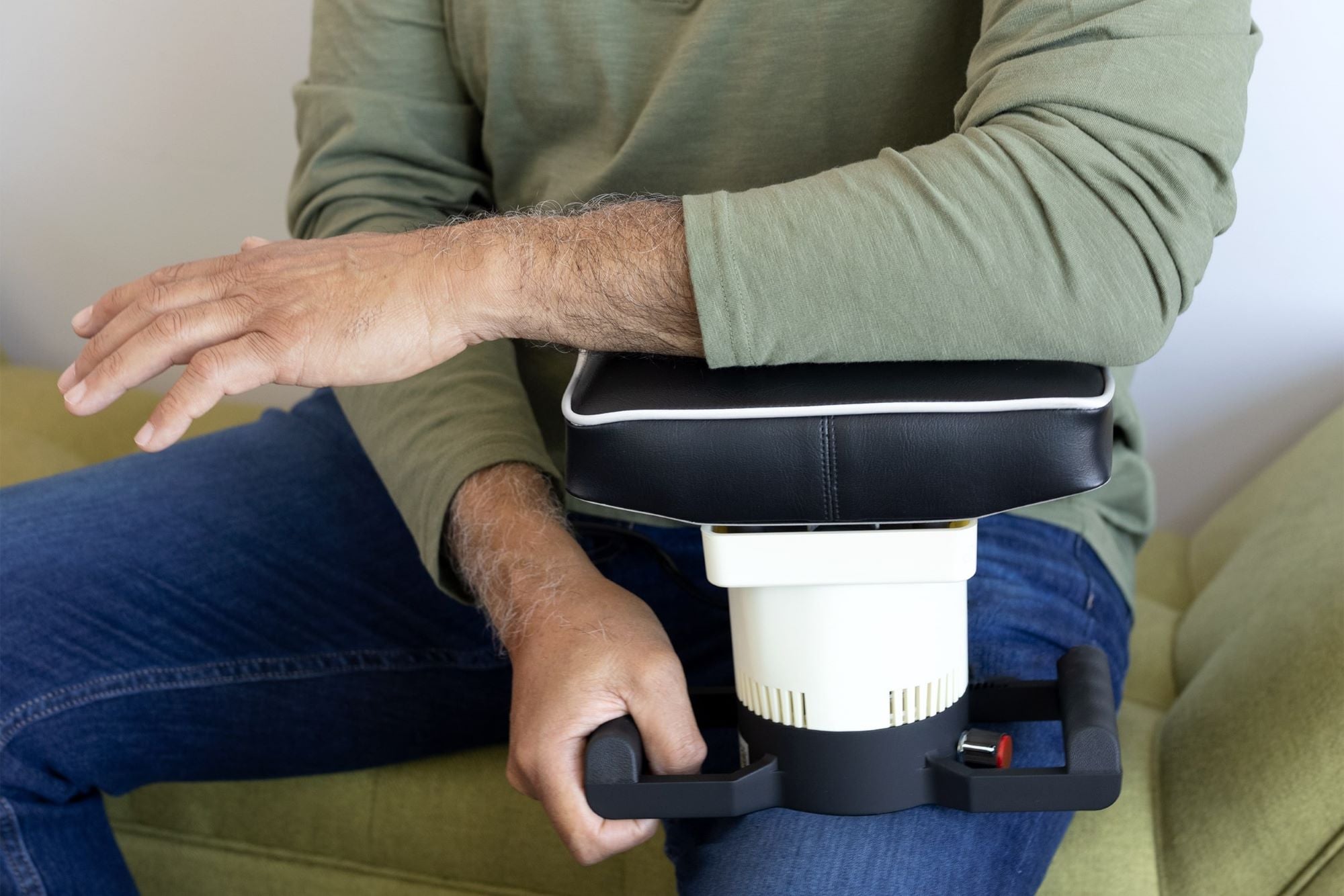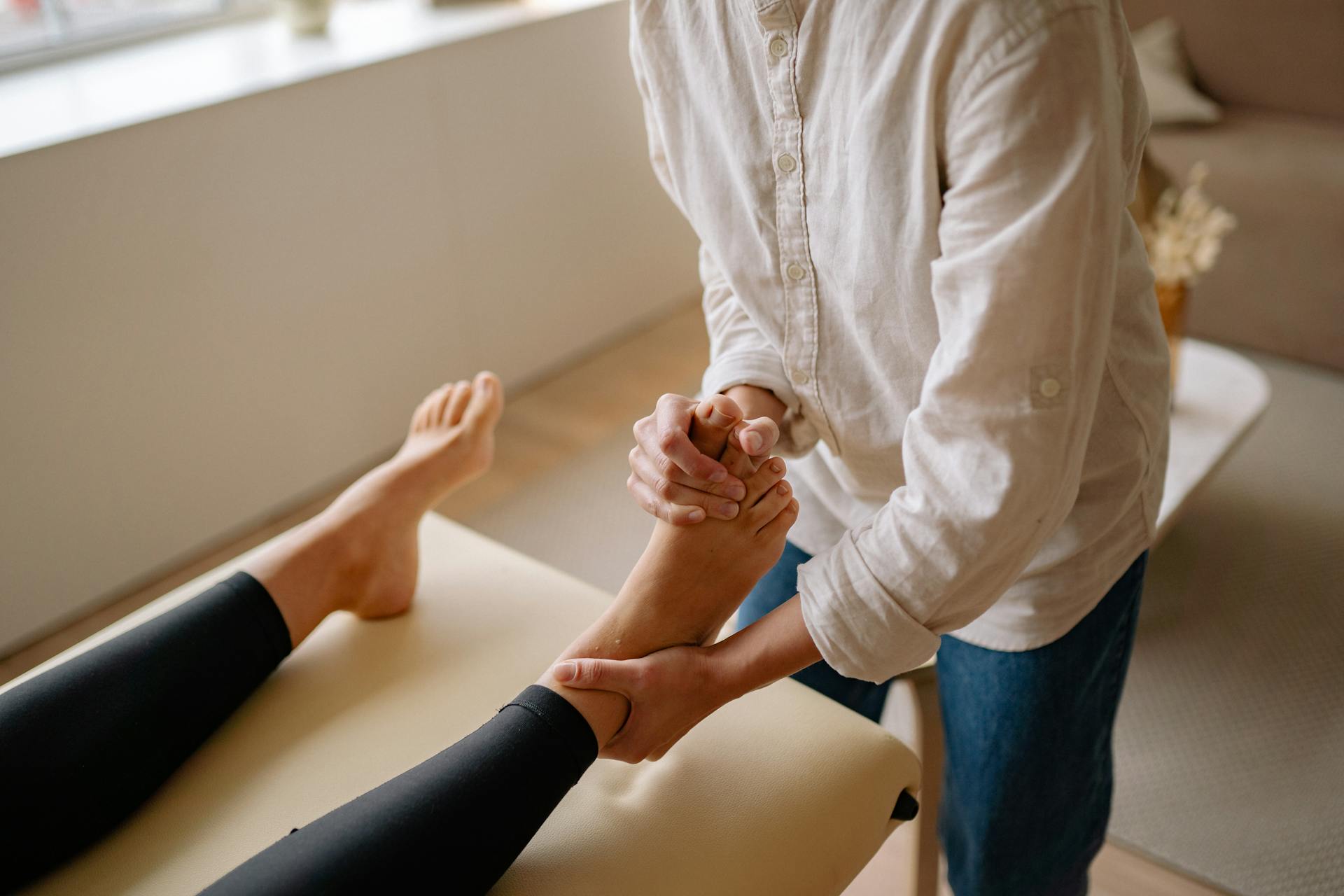If you’re always battling chilly hands and feet, you know the challenges that come with poor circulation in cold weather.
When the temperatures drop, it can reduce blood flow and leave you with a range of uncomfortable symptoms — namely in your hands, fingers, feet, and toes. But if you’re looking for ways to improve circulation in your lower body, could foot massage be worth a try?
Read on to learn everything you need to know about foot massage in the cooler season, including its circulatory benefits, techniques, and more.
What Causes Poor Circulation in Cold Weather?
In short, cold weather causes vasoconstriction — aka narrowing of the blood vessels that makes it tougher for your heart to pump blood. In turn, it can become more difficult to get enough oxygen, nutrients, and warmth in your extremities, especially the fingers and toes.
In addition, your body has to work harder to stay warm in the colder weather — meaning it diverts more blood toward your vital organs and less toward your hands and feet. For some people, this can lead to symptoms like:
- Paler skin
- Numbness
- Pins and needles sensations
- Cold skin
Conditions That Affect Poor Circulation in Cold Weather
Having certain conditions can also make you more sensitive to cold weather’s effects on circulation.
One example is Raynaud’s syndrome, a condition characterized by poor circulation in the fingers and toes in response to cold and stress. But other ailments can also affect blood flow in chilly weather, including:
- High blood pressure
- Diabetes
- Autoimmune conditions
- Certain cardiovascular diseases like peripheral artery disease (PAD)
Treatments
Your unique medical history will affect your treatment options for poor circulation, especially if you have any underlying health issues that haven’t been addressed.
But for poor circulation in your fingers and toes (or Raynaud’s disease), your doctor may recommend:
- Calcium-channel blockers, which open up the blood vessels and support healthy blood flow
- Vasodilators to help relax and widen blood vessels
- Biofeedback therapy
How Can Foot Massage Help Poor Circulation in Cold Weather?
Fortunately, massage has plenty of perks that could make a difference when you notice poor circulation in your feet. These include:
Calming the Nervous System
Did you know that too much stress can impact your circulation?
This is because of cortisol and other stress-related hormones, which increase heart rate and blood pressure. And in Raynaud’s syndrome specifically, both cold and stress are known to be triggers for poor circulation in the hands and feet.
Fortunately, massage can be a powerful tool for stress relief. When done properly, it brings several soothing effects to the body — calming the heart rate, temporarily reducing blood pressure, and triggering your relaxation response. In turn, it may help support healthy circulation as a whole.
Warming Your Muscles
The physical friction of foot massage has a direct warming effect on the feet. And as a bonus, it can reduce the muscle stiffness that sometimes comes with lower temperatures.
In other words, a few minutes of foot massage may be able to restore some of the lost heat in your icy feet and toes.
Encouraging an In-the-Moment Blood Flow Boost
Because massage provides heat, it can also promote an in-the-moment blood flow boost. Specifically, the warmth can encourage vasodilation and allow more blood to circulate throughout your feet, reducing feelings of cold and numbness.
And that’s not all — thanks to the boost in circulation, the tissues in your feet will have more access to nutrients and oxygen, supporting healthier feet overall.
In one small 2020 study, researchers looked at the effects of self-Thai foot massage on 25 type 2 diabetic patients. Remarkably, they found that a short session led to a boost in skin blood flow, along with improved foot and ankle range of motion.
4 Foot Massage Techniques for Poor Circulation

How can you try foot massage for yourself? Here are four options to explore, whether you want to use home tools or warm up your feet with your own two hands.
1. Oscillating Massage
Oscillating massagers are excellent home massage tools for two reasons: They’re hands-off (meaning you get to avoid any manual kneading or rubbing), and their vibration technology offers unique benefits for the feet.
In one randomized controlled trial, researchers found that whole-body vibration helped boost skin blood flow in the lower extremities for 10 minutes (or more) after use. And in general, vibrating foot massagers can help relieve aches, pains, and stiffness in tired feet.
With that in mind, here’s how to use one:
- Turn your device on to its gentlest setting.
- Rest your feet on the massager, and allow the light oscillation to warm up your muscles for 60 seconds.
- Increase the massage intensity to moderate (or whatever level is most comfortable for you).
- Relax and let the vibrations work into your muscles for 5-10 minutes.
2. Hands-On Foot Massage
In lieu of fancy home massage tools, it’s also incredibly easy to give yourself a hands-on foot massage. Here are two techniques that you can try right now:
All-Over Foot Massage
- Sit in a comfortable chair, and cross one leg up over your opposite knee.
- Use your thumbs to warm up the bottom of the foot, rubbing in circular motions. Repeat for 1-2 minutes.
- Then, use your knuckles to glide up and along the arch of the foot for 1-2 minutes more.
- Finally, finish the massage by kneading (or squeezing) your foot for 1-2 minutes. Feel free to focus on areas that could use the circulation boost most.
Toe-Focused Massage
- Start with one foot crossed up over your knee.
- Begin with warm-up twists on the bottom of your foot for 30 seconds. This technique involves side-to-side kneading motions using the base of your thumbs.
- Next, it’s time for toe spreads — outward spreading motions using the base of your thumbs. Start at the center of your foot and make your way upward for 30 seconds more.
- Once you reach the toes, spend a few seconds gently bending each toe forward and backward.
- Finally, finish the massage by kneading and squeezing each toe for 30 seconds.
3. Massage Ball
Using a massage ball is one of the easiest, most straightforward ways to give yourself a foot massage at home.
To try it, grab a ball of your choice — a tennis ball, lacrosse ball, or even a golf ball can all work well.
Next, sit in a comfortable chair, and place the ball under your foot. You can then spend 2 to 3 minutes rolling the bottom of your foot with whatever pressure level feels best to you.
4. Lower Leg Foam Rolling
Foam rollers are common in gyms and typically used for larger muscle groups — but if you have one on hand, you can try this technique to give yourself a quick calf and foot massage:
- Sit on the ground, and place the roller in front of you.
- Extend your legs, and cross one leg over the other on top of the roller.
- Use your upper body strength to lift your hips off the ground, and roll the calf for 30 to 60 seconds.
- Switch legs, and repeat for 30 to 60 seconds.
- To roll the feet, simply stand up and place one foot on the roller.
- Lean into the roller with moderate pressure, and slowly roll the foot for 30 to 60 seconds.
- Repeat with the other side.
How Often Should You Use Foot Massage — and for How Long?

Foot massage is a natural way to stimulate blood flow, and for most people, it's a fairly safe tool. But how often (and for how long) is it recommended to use foot massage? And is there any such thing as too much?
In short, a daily 10-20 minute foot massage can be enough for you to reap the wellness-boosting benefits.
To avoid going overboard, many experts recommend staying under 30-90 minutes of foot massage per day. However, this number could be different for you depending on the pressure, your doctor’s recommendations, and the tools you’re using.
For example, self-myofascial release tools (like foam rollers) only require about a minute or two per muscle group, while oscillating massagers can safely be used for a bit longer. When in doubt, it’s always a good idea to chat with your doctor and check your massage tool manuals.
Are There Any Times You Should Avoid Foot Massage?
Other than overdoing it on massage, there are also some occasions when it’s best to check with your healthcare provider before giving it a go.
Be sure to get the OK if you:
- Have a medical condition. Ailments like cancer, kidney issues, and certain cardiovascular diseases can sometimes interact poorly with massage. In these cases, it’s always essential to talk to a healthcare professional first.
- Have a skin condition, bruising, or open wounds
- Have a history of blood clotting disorders or any symptoms of a potential blood clot
- Are pregnant
- Have acute inflammation or an injury in your feet or lower legs
Other Remedies for Poor Circulation in Cold Weather
A foot massage can offer some relief when you have poor circulation in cold weather. But what other remedies can help keep your symptoms at bay?
Here are three tips to promote healthy circulation, warm up your feet, and boost blood flow in the winter:
Bundle Up
Keeping your feet warm and protected is one of the best ways to combat poor circulation in the winter. (And by keeping your body from losing heat as quickly, it also helps to reduce the strain on your heart in the cold.)
Wearing a few layers of socks is a great way to warm up your feet during the chilly season. Aside from that, you can also talk to your doctor about tools like compression socks to encourage blood flow in your lower legs.
Exercise Regularly
It’s no secret that exercise is great for your heart — and by adding a moderate level of movement to your routine, you can promote better whole-body circulatory health.
A good start is to take a brisk walk around your house (or anywhere with a regulated temperature) a few times per week. You can also use specific exercises that target the feet and ankles, including:
- Ankle flexion and extensions: Extend your legs and point your toes. Then, flex your feet back to point your toes up toward you. Repeat 10-20 times.
- Heel and toe raises: Stand with your feet hip-width apart. Push up onto your tiptoes, and slowly lower back to the ground. Repeat 10-20 times.
Add More Heat to Your Day
Another helpful remedy to combat poor circulation in cold weather is to simply stay warm.
Tools like space heaters, electric blankets, warm clothing, and hand warmers can all work wonders when your feet could use a boost. Alternatively, you can also make it a point to soak your feet in a warm bath daily.
Preventative Measures: Improving Circulation Long-Term
Here are some of the most important things you can do to support healthy circulation as a whole:
Cut Back on Caffeine, Alcohol, and Nicotine
If you’re someone who relies on coffee to get through the day, you’re certainly not alone. But while a little bit of caffeine usually isn’t any cause for concern, too much can lead to temporary vasoconstriction — meaning it may worsen the symptoms of poor circulation in cold weather.
In fact, it can even be a trigger for Raynaud’s syndrome in some people.
With that being said, be sure to keep your caffeine intake to moderate levels. Beyond that, nicotine and alcohol can also impact blood flow, so it’s important to keep an eye on your intake of these substances as well.
Eat a Balanced Diet
A balanced diet is good for keeping you generally healthy, and it’s also an excellent way to support your body’s circulatory system.
The best foods for poor circulation in cold weather include antioxidant-rich fruits and vegetables that can help promote healthy blood vessels and low blood pressure. Plus, foods with omega-3 fatty acids can also support your heart health.
If you’re not sure where to start, try adding a few of these to your daily diet:
- Blueberries, which are rich in antioxidants and vitamin C
- Pomegranates, which are full of nitrates and antioxidants that help promote blood flow
- Walnuts, which are full of omega-3 fatty acids
- Fatty fish like salmon and tuna, which may help reduce blood pressure
Tip: Being mindful of your sugar and salt intake can also make a positive impact on your circulatory health.
Keep Your Temperature Stable
People prone to poor circulation in cold weather — and especially those with Raynaud’s phenomenon — might notice their symptoms worsening when they face jarring transitions between temperatures.
This is all the more the reason to ensure you have the proper gear every time you go out into the cold. Doing your best to regulate your temperature no matter where you are can help prevent the discomfort that comes with icy weather.
When To Check With Your Doctor
As mentioned earlier, it’s essential to talk to your doctor before trying massage if you have a pre-existing medical condition. But when should you make an appointment for poor circulation in cold weather — or blood flow issues in general?
In short, you should always visit a healthcare professional if you notice persistent circulation problems.
Beyond that, seek immediate medical attention if you have symptoms of deep vein thrombosis (DVT). These include:
- Swelling in the legs and feet
- Throbbing pain or cramping in the calf or thigh
- Heat near a painful spot on the leg
- Discolored skin on the leg
The Takeaway
Lower temperatures can constrict your blood vessels and make it tougher for your body to deliver blood, oxygen, and nutrients to your feet — meaning it’s common to experience poor circulation in cold weather.
The good news? Massage is one home remedy that may bring relief. It can physically warm your muscles while encouraging blood flow, better range of motion, and stress relief, which can support your body on a holistic level.
Keep in mind that poor circulation might indicate an underlying medical condition, so be sure to talk to your doctor before getting started. Not only can this ensure that massage is safe for you, but it can also get you on track to the right treatment plan for your unique health.
Getting Started With Home Foot Massage
For daily relief in the comfort of your home, pick up the physician-trusted MedMassager Foot Massager Plus today. Or, view our full line of restorative tools here.



